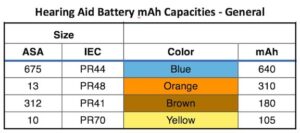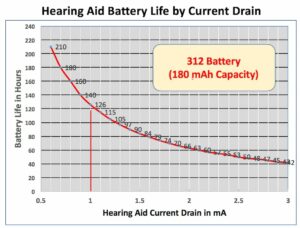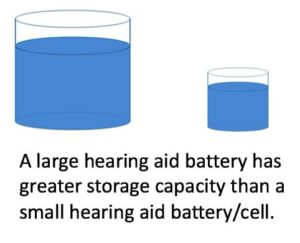My Hearing Aid Battery Doesn’t Last Long, So What Can be Happening?
My post last week suggested that when advanced hearing aid features are activated (adaptive noise cancellation, adaptive directionality, etc.), while they seemed to have essentially no significant impact on hearing aid delay performance, these feature activations do have an impact on the current drain. And, current drain determines hearing aid battery life – the higher the current drain, the shorter the battery life.
A Review
Last week’s post related to measuring the impact of advanced hearing aid features on delay, the time involved from the initial stimulus reception by the hearing aid until it is processed and delivered to the hearing aid speaker/receiver. Delay is characteristic of digital hearing aids, with the suggestion that long delay times could be audible, objectionable, or even result in auditory confusion. However, results of measurements made during the past seven years suggests that delay times appear to be sufficiently short (less than 10 msec.) to have any significant impact, regardless of whether advanced hearing aid performance features were activated or not.
However, last week’s post suggested that when advanced hearing aid features are activated, measurement results show that such activation has an impact on current drain, and this could be significant.
The Relationship Between Current Drain and Battery Life
 Generally, battery life is calculated based on the current rating in milli Amperes per Hour and it is abbreviated as mAh. Ampere is an electrical unit used to measure the current flow towards the load – in this case, the hearing aid amplifier. The battery life can be calculated from the input rating of the battery and the load current of the circuit. Battery life will be high when the load current is less and vice versa. The calculation to find out the capacity of a battery can be mathematically derived from the formula on the right.
Generally, battery life is calculated based on the current rating in milli Amperes per Hour and it is abbreviated as mAh. Ampere is an electrical unit used to measure the current flow towards the load – in this case, the hearing aid amplifier. The battery life can be calculated from the input rating of the battery and the load current of the circuit. Battery life will be high when the load current is less and vice versa. The calculation to find out the capacity of a battery can be mathematically derived from the formula on the right.
Hearing Aid Battery Capacity in Milli-Amps per Hour
Many companies manufacture hearing aid batteries. However, they all use the same color coding to differentiate the four main sizes of batteries.

Figure 1. Hearing aid battery identifications and mAh capacities. These will vary slightly between different battery companies. ASA (American Standards Institute) and IEC (International Electrotechnical Commission) size identifications. Some companies often use a different letter(s) in front of the numbers, but all use the color combination for proper identification.
Example
A hearing aid using a size 312 and having a current drain of 1 mAmp would have a battery life of 126 hours as calculated from the formula (Figure 2). If hearing aids had a constant current drain, battery life could be predicted reasonably. Unfortunately, they do not have constant current drain, meaning that when more is asked of the hearing aid circuitry (adaptive features, etc.), current drain increases and battery life shortens.
Hearing aid manufacturers generally publish expected battery life based on the hearing aid being measured according to ANSI (American National Standards Institute) S3.22, 2003, meaning that the hearing aid is set without its adaptive features operating. For example, the published specifications may record the current drain at 1.0 mA (mAmp), and as in Figure 2 for a size 312 battery, would provide a calculated 126 hours of battery life. However, when the hearing aid is operating with its adaptive features activated (adaptive noise cancellation, adaptive feedback cancellation, adaptive directionality, etc.), it can be expected to pull a higher current drain. If it pulled 1.8 mA, the expected battery life would then be 74 hours – a reduction of not quite half! Of course, any audio streaming associated with hearing aids would pull an even higher current drain and shorten the battery life even more.

Figure 2. Calculated battery life in hours for a size 312 hearing aid battery when operating under different current drains. Any adaptive features performed by the hearing aid can be expected to result in a higher current drain (and hence, shorter battery life) when operating. The battery life of different sized hearing aid batteries will be different because their “storage tanks” (mAh Capacity) is different than the 180 mAh capacity in this example. Some have greater storage and others less, depending on the size of the battery, with smaller batteries having less storage.
A Layman’s Simplified Guide to Current Drain

Figure 3. The size of hearing aid batteries determines their storage capacity (mAh). A larger battery has greater storage than a smaller battery – much like two different water storage tanks.
Think of a hearing aid battery as a water tank where a certain amount of water (energy) is stored until it is to be released. The larger the tank, the greater the storage (Figure 3).
When water is released from the tank through a hose, think of this as current (like in a stream). The volume of water flowing through the hose over a certain period of time can be measured. The larger the hose, the greater the volume to be measured and vice versa. The difference being that it is the amount of current flowing, rather than water.

Figure 4. Current drain of a hearing aid battery can be likened to the flow of water from a storage tank. The lower the current drain, the longer it will take to empty the storage tank.
Current is measured in Amperes (Amps). Using the water tank as an example, if we have two tanks, each with the same amount of water, but with hoses emerging of two different sizes, when water begins to flow, the rate (drain) will be less in the tank with the narrow hose (Figure 4). In electrical terms, we would say that the flow rate (drain) from the tank with the narrower hose would have less current (and hence, less current drain), than that of the wider hose. (Battery voltage and resistance come into play also, but are not germane to this discussion).
Do Hearing Aids Have the Same Current Drain?
Figure 5, taken from a student project at Purdue University (Alexander, 2016), provides the current drain for hearing aids they tested. These values were with adaptive features turned “ON.” These hearing aids did not all have the same battery, and hence the current drains measured cannot be compared directly. The real purpose of providing this graph is to show that not all hearing aids have the same current drain. Still, the four hearing aids using the 312 cell produced current drains from 0.7 to 1.4 mA. Check Figure 2 to determine how much difference in battery life these hearing aids allowed.

Figure 5. Current drain for seven different hearing aids from the year 2009 (Alexander, 2016). The range was from 0.7 to 1.6 mA. From left to right, hearing aids 1, 2, and 7 were powered by size 13 cells. The remainder were powered by 312 cells.
Next week’s post will look at this topic again in a way that is more meaningful when it compares the same hearing aid’s current drain against itself with adaptive features turned “Off” and then “On.”
References
Alexander, J. (2016). Personal communication. Purdue University.
About the author
Wayne Staab, PhD, is an internationally recognized authority in hearing aids. As President of Dr. Wayne J. Staab and Associates, he is engaged in consulting, research, development, manufacturing, education, and marketing projects related to hearing. His professional career has included University teaching, hearing clinic work, hearing aid company management and sales, and extensive work with engineering in developing and bringing new technology and products to the discipline of hearing. This varied background allows him to couple manufacturing and business with the science of acoustics to bring innovative developments and insights to our discipline. Dr. Staab has authored numerous books, chapters, and articles related to hearing aids and their fitting, and is an internationally-requested presenter. He is a past President and past Executive Director of the American Auditory Society and a retired Fellow of the International Collegium of Rehabilitative Audiology.
**this piece has been updated for clarity. It originally published on February 9, 2016







Based on a science project by an 8th grader whose tests indicated a battery life by leaving the HA battery exposed at least five minutes before inserting in the hearing aid, I started by own study. I have since left the battery exposed anywhere from 5 minutes to overnight. Since my study began in Sept 2015, until today, by this practice I have gotten no less than 12 days mostly 13 & 14 days) of usage compared to the normal 7 days before. This has become a standard practice for me now
Wayne:
Nice review of battery current drain. At ZPower we have been trying to develop a better understanding of actual versus published current drains with different products. As you noted, published current drains are based on ANSI standards that basically turn off all the features. It’s not uncommon for published current drains to be around 1.0-1.2 mAh making the audiologist believe that the hearing aid will work for 2 weeks on a single battery. However, in the real world, not only are features like noise and feedback management activated, but today, so is ear-to-ear and wireless streaming. We are presenting a paper at AAA in April that will show actual current drains with wireless hearing aids can average 1.8-2.4 mAh WITHOUT streaming and, in the case of far-field 2.4gHz products, drain can average between 4.5-5.5mAh. This information has h(UGE) implications for counseling patients about battery life and why we are so focused on rechargeable batteries that will permit patients to never again worry about dying batteries. Thanks for some great information.
Barry
Just by switching brands I’ve seen battery life (size 10) go from 3-4 days to 5-7 days. This is with the same hearing aids and roughly the same conditions. Alas the long life one that was carried by Radio Shack at one time (“You’ve got questions — We’ve got batteries!”) is no longer. No idea who the original manufacturer was but now I’m back to 3-4 days at best. I’m sure build date, environment during shipping also factor into it. Plus the batteries may have a different discharge curve.
I may switch form factors for a larger device next time, just to get the improved battery capacity. Also, my use of wireless capabilities and streaming were quickly curtailed by very reduced battery life. I have streaming devices I no longer use simply because the hearing aid battery would last only a few hours total.
Grant
Would like to know more re the poor battery life?
What were you streaming,a little more of the back ground!
Gloria: When you say exposed, do you mean outside the hearing aid and with the activation tab on or off? Can I assume also that this is the same hearing aid(s) as when you obtained about 7 days? And, was the 7 days typical of all year use, or representative of what occurred during the summer?